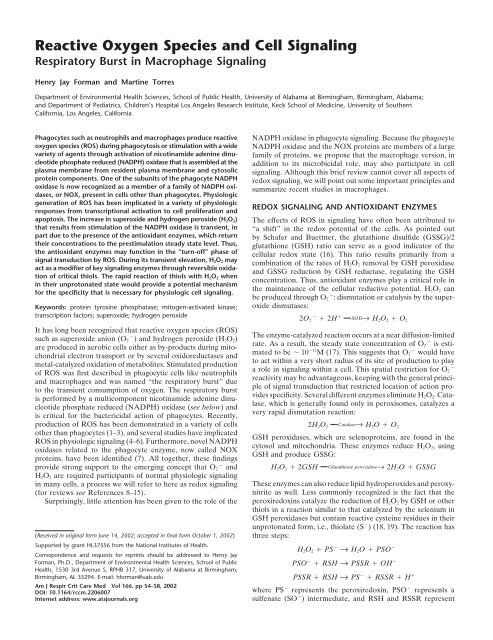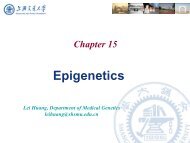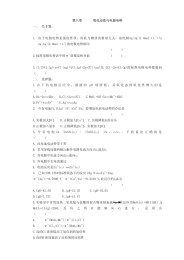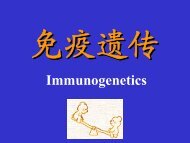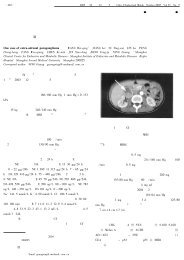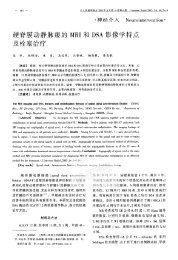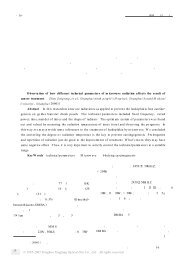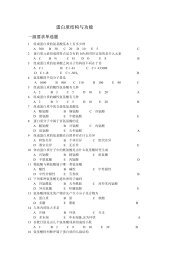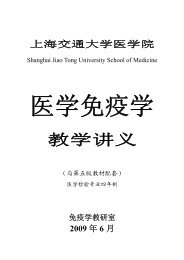Reactive Oxygen Species and Cell Signaling
Reactive Oxygen Species and Cell Signaling
Reactive Oxygen Species and Cell Signaling
You also want an ePaper? Increase the reach of your titles
YUMPU automatically turns print PDFs into web optimized ePapers that Google loves.
<strong>Reactive</strong> <strong>Oxygen</strong> <strong>Species</strong> <strong>and</strong> <strong>Cell</strong> <strong>Signaling</strong><br />
Respiratory Burst in Macrophage <strong>Signaling</strong><br />
Henry Jay Forman <strong>and</strong> Martine Torres<br />
Department of Environmental Health Sciences, School of Public Health, University of Alabama at Birmingham, Birmingham, Alabama;<br />
<strong>and</strong> Department of Pediatrics, Children’s Hospital Los Angeles Research Institute, Keck School of Medicine, University of Southern<br />
California, Los Angeles, California<br />
Keywords: protein tyrosine phosphatase; mitogen-activated kinase;<br />
transcription factors; superoxide; hydrogen peroxide<br />
NADPH oxidase in phagocyte signaling. Because the phagocyte<br />
NADPH oxidase <strong>and</strong> the NOX proteins are members of a large<br />
family of proteins, we propose that the macrophage version, in<br />
addition to its microbicidal role, may also participate in cell<br />
signaling. Although this brief review cannot cover all aspects of<br />
redox signaling, we will point out some important principles <strong>and</strong><br />
summarize recent studies in macrophages.<br />
REDOX SIGNALING AND ANTIOXIDANT ENZYMES<br />
Phagocytes such as neutrophils <strong>and</strong> macrophages produce reactive<br />
oxygen species (ROS) during phagocytosis or stimulation with a wide<br />
variety of agents through activation of nicotinamide adenine dinucleotide<br />
phosphate reduced (NADPH) oxidase that is assembled at the<br />
plasma membrane from resident plasma membrane <strong>and</strong> cytosolic<br />
protein components. One of the subunits of the phagocyte NADPH<br />
oxidase is now recognized as a member of a family of NADPH oxidases,<br />
or NOX, present in cells other than phagocytes. Physiologic<br />
generation of ROS has been implicated in a variety of physiologic<br />
responses from transcriptional activation to cell proliferation <strong>and</strong><br />
apoptosis. The increase in superoxide <strong>and</strong> hydrogen peroxide (H 2 O 2 )<br />
that results from stimulation of the NADPH oxidase is transient, in<br />
part due to the presence of the antioxidant enzymes, which return<br />
their concentrations to the prestimulation steady state level. Thus,<br />
the antioxidant enzymes may function in the “turn-off” phase of<br />
signal transduction by ROS. During its transient elevation, H 2 O 2 may<br />
act as a modifier of key signaling enzymes through reversible oxida-<br />
tion of critical thiols. The rapid reaction of thiols with H 2 O 2 when<br />
in their unprotonated state would provide a potential mechanism<br />
for the specificity that is necessary for physiologic cell signaling.<br />
The effects of ROS in signaling have often been attributed to<br />
“a shift” in the redox potential of the cells. As pointed out<br />
by Schafer <strong>and</strong> Buettner, the glutathione disulfide (GSSG)/2<br />
glutathione (GSH) ratio can serve as a good indicator of the<br />
cellular redox state (16). This ratio results primarily from a<br />
combination of the rates of H 2 O 2 removal by GSH peroxidase<br />
<strong>and</strong> GSSG reduction by GSH reductase, regulating the GSH<br />
concentration. Thus, antioxidant enzymes play a critical role in<br />
the maintenance of the cellular reductive potential. H 2 O 2 can<br />
be produced through O . 2 : dismutation or catalysis by the superoxide<br />
dismutases:<br />
2O . 2 2H SOD→ H 2 O 2 O 2<br />
It has long been recognized that reactive oxygen species (ROS)<br />
such as superoxide anion (O . The enzyme-catalyzed reaction occurs at a near diffusion-limited<br />
2 ) <strong>and</strong> hydrogen peroxide (H 2 O 2 )<br />
are produced in aerobic cells either as by-products during mitomated<br />
to be 10 11 M (17). This suggests that O . 2 would have<br />
rate. As a result, the steady state concentration of O . 2 is esti-<br />
chondrial electron transport or by several oxidoreductases <strong>and</strong><br />
metal-catalyzed oxidation of metabolites. Stimulated production<br />
to act within a very short radius of its site of production to play<br />
.<br />
of ROS was first described in phagocytic cells like neutrophils<br />
a role in signaling within a cell. This spatial restriction for O 2<br />
<strong>and</strong> macrophages <strong>and</strong> was named “the respiratory burst” due<br />
reactivity may be advantageous, keeping with the general princito<br />
the transient consumption of oxygen. The respiratory burst<br />
ple of signal transduction that restricted location of action prois<br />
performed by a multicomponent nicotinamide adenine dinulase,<br />
which is generally found only in peroxisomes, catalyzes a<br />
vides specificity. Several different enzymes eliminate H 2 O 2 . Cata-<br />
cleotide phosphate reduced (NADPH) oxidase (see below) <strong>and</strong><br />
is critical for the bactericidal action of phagocytes. Recently,<br />
very rapid dismutation reaction:<br />
production of ROS has been demonstrated in a variety of cells 2H 2 O 2 Catalase→ H 2 O O 2<br />
other than phagocytes (1–3), <strong>and</strong> several studies have implicated<br />
GSH peroxidases, which are selenoproteins, are found in the<br />
ROS in physiologic signaling (4–6). Furthermore, novel NADPH<br />
cytosol <strong>and</strong> mitochondria. These enzymes reduce H 2 O 2 , using<br />
oxidases related to the phagocyte enzyme, now called NOX<br />
GSH <strong>and</strong> produce GSSG:<br />
proteins, have been identified (7). All together, these findings<br />
provide strong support to the emerging concept that O . 2 <strong>and</strong> H 2 O 2 2GSH Glutathione peroxidase→ 2H 2 O GSSG<br />
H 2 O 2 are required participants of normal physiologic signaling<br />
in many cells, a process we will refer to here as redox signaling These enzymes can also reduce lipid hydroperoxides <strong>and</strong> peroxy-<br />
(for reviews see References 8–15).<br />
nitrite as well. Less commonly recognized is the fact that the<br />
Surprisingly, little attention has been given to the role of the peroxiredoxins catalyze the reduction of H 2 O 2 by GSH or other<br />
thiols in a reaction similar to that catalyzed by the selenium in<br />
GSH peroxidases but contain reactive cysteine residues in their<br />
unprotonated form, i.e., thiolate (S ) (18, 19). The reaction has<br />
(Received in original form June 14, 2002; accepted in final form October 1, 2002) three steps:<br />
Supported by grant HL37556 from the National Institutes of Health.<br />
Correspondence <strong>and</strong> requests for reprints should be addressed to Henry Jay<br />
Forman, Ph.D., Department of Environmental Health Sciences, School of Public<br />
Health, 1530 3rd Avenue S, RPHB 317, University of Alabama at Birmingham,<br />
Birmingham, AL 35294. E-mail: hforman@uab.edu<br />
Am J Respir Crit Care Med Vol 166. pp S4–S8, 2002<br />
DOI: 10.1164/rccm.2206007<br />
Internet address: www.atsjournals.org<br />
H 2 O 2 PS → H 2 O PSO <br />
PSO RSH → PSSR OH <br />
PSSR RSH → PS RSSR H <br />
where PS represents the peroxiredoxin, PSO represents a<br />
sulfenate (SO ) intermediate, <strong>and</strong> RSH <strong>and</strong> RSSR represent
Forman <strong>and</strong> Torres: Redox <strong>Signaling</strong> in Macrophages<br />
S5<br />
the thiol <strong>and</strong> disulfide forms of a compound, which may be GSH,<br />
thioredoxin (Trx), or some other thiol.<br />
We propose that the antioxidant enzymes may serve as turnoff<br />
enzymes in redox signaling. By analogy to the cyclic adenosine<br />
monophosphate second messenger signaling system, in<br />
which phosphodiesterase activity turns off signaling by decreasing<br />
cyclic adenosine monophosphate, the antioxidant enzymes<br />
would turn off signaling by decreasing their substrates. Thus, by<br />
restoring the low steady state ROS concentrations of oxidant<br />
second messengers, antioxidant enzymes cause the signal to be<br />
transient, another general characteristic of signal transduction.<br />
Further studies are warranted to test this point.<br />
SPECIFICITY OF ROS REACTIONS<br />
One potential mechanism for redox signaling could be via disulfide<br />
exchange between GSSG <strong>and</strong> protein thiols. However, there<br />
are countless protein thiols that could potentially undergo this<br />
reaction, thereby lacking specificity. The concept of specificity,<br />
one of the major characteristics of signaling pathways in general,<br />
is a challenge when it comes to the role of ROS in signaling,<br />
given that even their name implies high reactivity. Actually,<br />
H 2 O 2 is unreactive with thiols in the absence of catalysis, usually<br />
by transition metals. Metal-catalyzed reactions or peroxynitrite<br />
can oxidize cysteine to either a sulfinic or sulfonic acid that are<br />
not easily reduced. However, H 2 O 2 reacts readily with the far<br />
less common thiolate anion (-S ) to form sulfenic acid (-SOH),<br />
which at physiologic pH ionizes to form a sulfenate (-SO ) (pKa<br />
6.1) (20). This intermediate can be easily reduced, making the<br />
reaction reversible, another important principle in signaling. The<br />
S is only found in proteins where the cysteine, which has a pKa<br />
around 8.5, hence significantly higher than the physiologic range,<br />
is situated in a positively charged electrostatic field provided<br />
by surrounding residues that allows dissociation to the S <strong>and</strong><br />
stabilization of the structure. This has been well characterized<br />
while studying the mechanisms of catalysis by protein tyrosine<br />
phosphatases (PTP) (21). The presence in PTP of at least one<br />
reactive sulfhydryl that was essential for catalysis was hinted by<br />
the inhibition of PTP by alkylating agents. All PTP contain a<br />
highly conserved cysteine that resides in the PTP signature motif,<br />
HCXXGXXRST, <strong>and</strong> mutation of this cysteine residue results<br />
in loss of activity. This cysteine is in the form of a S <strong>and</strong> forms<br />
a thiophosphoenzyme intermediate during hydrolysis, acting as<br />
a nucleophile. The pKa of cysteine was measured to be around<br />
4.67 in Yersinia PTP. The His residue, which is also conserved<br />
in all PTP <strong>and</strong> is adjacent to the cysteine in the active site,<br />
together with an -helix that follows the phosphate-binding loop<br />
generate a dipole that contributes to the low pKa (22, 23). The<br />
active site of peroxiredoxins also provides the proper microenvi-<br />
ronment for formation of S , as mentioned previously. The con-<br />
served catalytic site of the Trx family of proteins contains two<br />
cysteine residues, one of which is S that can form SO . The<br />
second cysteine then reacts with SO to form an intramolecular<br />
disulfide bridge. The intramolecular disulfide bond cannot be<br />
readily reduced by GSH. Instead, the enzyme, Trx reductase<br />
catalyzes an NADPH-dependent reduction of the disulfide to<br />
restore Trx to its reduced form:<br />
Figure 1. The active site S in PTPs can react with H 2 O 2 to form SO .<br />
This form of the enzyme is catalytically inactive. GSH can react with<br />
SO to form a mixed disulfide that can then react with another GSH<br />
to form GSSG <strong>and</strong> restore the active form of the PTP. The reaction is<br />
analogous to that catalyzed by GSH-dependent peroxiredoxins.<br />
inhibited the PTP activity, which was restored by thiols, suggesting<br />
the formation of a sulfenic acid (-SOH) intermediate<br />
(21). This was later confirmed by in vivo studies (27). The predominant<br />
thiol reducing the sulfenic acid/sulfenate is most likely<br />
GSH as its cellular concentration ranges from 1 to 10 mM (Figure<br />
1). Interestingly, the oxidation of PTP <strong>and</strong> reduction by GSH<br />
has the same chemistry as that of the peroxiredoxin reaction<br />
shown previously, <strong>and</strong> it will be important to further determine<br />
the role of these enzymes in redox signaling. A recent study by<br />
Meng <strong>and</strong> coworkers brought additional support for the role of<br />
PTP inhibition by H 2 O 2 in physiologic signaling (28). The PTP,<br />
SHP-2, which has a Src homology 2 (SH2) domain, binds through<br />
this domain to a phosphotyrosine in the intracellular domain<br />
of the activated tyrosine kinase receptor on stimulation with<br />
platelet-derived growth factor, which is also known to induce<br />
ROS production. In this paper, they demonstrated that the spe-<br />
cific, spatiotemporal, <strong>and</strong> reversible inhibition of SHP-2 was<br />
necessary for both downstream platelet-derived growth factor<br />
signaling <strong>and</strong> turn-off. Only the SHP-2 activity associated with<br />
the receptor was altered by H 2 O 2 <strong>and</strong> activation of the same<br />
cells with epithelial growth factor, which also induces ROS production,<br />
did not result in SHP-2 inhibition. Thus, the reaction<br />
of S with H 2 O 2 is specific, reversible, <strong>and</strong> directly connected<br />
to changes in the generation of H 2 O 2 , providing a mechanism<br />
consistent with a fundamental role in redox signaling.<br />
ROS TARGETS<br />
As mentioned previously, a large body of evidence has now<br />
indicated that endogenously produced ROS are participants of<br />
several signal transduction pathways in many cells. Except for<br />
H 2 O 2 Trx(SH)(S ) → H 2 O Trx(SH)(SO )<br />
the study mentioned previously, which suggests that the PTP is<br />
Trx(SH)(SO ) → TrxSS OH <br />
the main target for H 2 O 2 , the exact targets in the ROS-sensitive<br />
pathways have just begun to be identified. Here, we will only<br />
TrxSS NADPH Trx Reductase→ Trx(SH)(S ) NADP briefly mention pathways that are relevant to the section on<br />
Thus, the reaction with H 2 O 2 being restricted to such proteins, redox signaling in macrophages (for more extensive reviews see<br />
specificity may ensue (21, 24–26). References 8–14).<br />
A few years ago, Denu <strong>and</strong> Tanner demonstrated in vitro The first signaling components to be identified as redox sensithat<br />
the reaction of the S with low concentrations of H 2 O 2 tive were transcription factors. Nuclear factor-B (NF-B), a
S6 AMERICAN JOURNAL OF RESPIRATORY AND CRITICAL CARE MEDICINE VOL 166 2002<br />
critical transcription factor for the expression of inflammatory they may need to acquire an activated phenotype to upregulate<br />
mediators, is sequestered in the cytosol in a complex with its their bactericidal capability. Redox signaling may help orches-<br />
inhibitor IB. ROS have been demonstrated to induce activation trating the inflammatory response by inducing the synthesis of<br />
of NF-B, although the mechanisms are not clearly understood cytokines that affect macrophages <strong>and</strong> induce neutrophil influx.<br />
<strong>and</strong> may not involve a direct effect of ROS on NF-B (for review, In fact, several studies have now suggested that ROS can regulate<br />
see Reference 29). Activator protein-1 is a transcription factor the production of cytokines in macrophages through mechanisms<br />
complex formed by homo- or heterodimerization of members that are dependent on NF-B. In Kupffer cells, the resident<br />
of the Jun <strong>and</strong> Fos families of proteins (for review, see References macrophage in the liver, production of tumor necrosis factor-<br />
30 <strong>and</strong> 31). ROS can regulate activator protein-1 activity through was regulated by a ROS-activated NF-B pathway (39). Liposeveral<br />
mechanisms <strong>and</strong> targets that may include the reversible polysaccharide, which stimulates the production of tumor necro-<br />
S-glutathiolation of a single conserved cysteine residue, as demdent<br />
sis factor , induced the production of ROS via a pathway depenonstrated<br />
in vitro (32), the reversible redox regulation by Trx<br />
on Rac1 <strong>and</strong> the activation of NF-B through IB kinases in<br />
<strong>and</strong> the nuclear protein Ref1 (33). It can also be regulated RAW 264.7 cells (40). Various known stimulants of the NADPH<br />
through the c-Jun N-terminal kinase cascade. The c-Jun N-termisilica<br />
oxidase were also shown to trigger NF-B activation such as<br />
nal kinases are part of the mitogen-activated protein kinase<br />
in mouse peritoneal macrophages (41, 42) or ADP <strong>and</strong><br />
(MAPK) superfamily of serine/threonine kinases that also incyte/macrophage<br />
phorbol myristate acetate in rat AM <strong>and</strong> the J774.1 mouse monocludes<br />
the extracellular signal-regulated kinases ERK1 <strong>and</strong><br />
cell line (43). Furthermore, in primary AM<br />
ERK2 <strong>and</strong> the p38 MAPK . All MAPKs are activated through a <strong>and</strong> in RAW 264.7, the production of ROS by silica resulted in<br />
cascade of phosphorylation, also referred to as the MAPK core downstream signaling <strong>and</strong> production of tumor necrosis factor-<br />
or module, <strong>and</strong> have the unusual particularity to require phos- , which was inhibited by superoxide dismutase <strong>and</strong> catalase<br />
phorylation on both threonine <strong>and</strong> tyrosine residues within a TxY (44). These effects may differ with stimulus <strong>and</strong> cell types as<br />
motif for full activation. One of the upstream kinases in the c- adherence to plastic <strong>and</strong> exposure to particulates stimulated<br />
Jun N-terminal kinase <strong>and</strong> p38 MAPK modules is the apoptosis-signal the respiratory burst in human AM but did not induce NF-B<br />
regulating kinase-1, which is maintained in an inactive state by activation (45). It was recently demonstrated that pulmonary<br />
bound reduced Trx. Oxidation of Trx by ROS releases apoptosisp47<br />
NF-B activation was altered in a knockout mouse model lacking<br />
signal regulating kinase-1, permitting its activation <strong>and</strong> downstream<br />
phox <strong>and</strong> thereby deficient in functional NADPH oxidase <strong>and</strong><br />
signaling (34–36). Thus, the apoptosis-signal regulating ROS production in phagocytes (46), indicating the importance<br />
kinase-1/MAPK <strong>and</strong> the PTP are so far the best described signalto<br />
of this pathway in lungs <strong>and</strong> the utility of such mouse models<br />
ing pathway/molecules for which the mechanism of action of ROS<br />
study the effects on ROS. Activator protein-1 was also acti-<br />
has been identified.<br />
vated in rat AM under hyperoxia, which is known to increase<br />
ROS levels (47).<br />
SIGNALING BY ROS IN MACROPHAGES<br />
The ERK pathway was one of the first signaling pathways<br />
for which the link between the extracellular lig<strong>and</strong> <strong>and</strong> the nu-<br />
It took several years after the discovery of the production of cleus was described. The signaling module of the ERK pathway<br />
ROS by phagocytes by Babior <strong>and</strong> coworkers (37) to uncover is composed of ERK1/2, the dual-specificity kinases MEK1/2,<br />
the characteristics of the responsible enzyme. It is now clear <strong>and</strong> isoforms of Raf <strong>and</strong> is principally activated by hormones<br />
that the physical separation of the NADPH oxidase components <strong>and</strong> growth factors (48). Exogenous H 2 O 2 activates ERK1 <strong>and</strong><br />
between the cytosol <strong>and</strong> the plasma membrane in the nonstimu- ERK2 in many cell types, although this activation appears to be<br />
lated cells prevents its activation unless phagocytosis or soluble cell type specific (49–52). Further studies showed that increased<br />
stimuli trigger assembly. The cytosolic complex composed of a intracellular production of ROS also activated the ERK (53).<br />
p47 phox /p67 phox /p40 phox , <strong>and</strong> the small GTPase Rac1/Rac2 sepa- In NR8383 rat AM, treatment with menadione, which induces<br />
rately move to the plasma membrane on stimulation <strong>and</strong> join the production of ROS through a mechanism presumably indewith<br />
the membrane-bound flavocytochrome subunits, gp91 phox pendent of the NADPH oxidase, activated ERK1, ERK2, <strong>and</strong><br />
<strong>and</strong> p22 phox to form the active oxidase complex. This NADPH p38 MAPK (54). Other studies have concentrated on the possible<br />
oxidase has the unusual characteristic of using an electron from role of the ROS produced by the NADPH oxidase/respiratory<br />
cytosolic NADPH to reduce extracellular O 2 to O . 2 :<br />
burst. Many stimuli that trigger the respiratory burst in phagocytes<br />
induce the activation of the ERK (55). Thus, ERK activa-<br />
NADPH 2O 2 NADPH oxidase→ NADP H .<br />
2O 2<br />
tion may be a consequence of the burst or may play a role in<br />
Nonenzymatic O . 2 dismutation to H 2 O 2 is rapid, but superoxide the assembly of the NADPH oxidase. The results for the latter<br />
dismutases accelerate the reaction by 10 4 -fold. Although extra- have been controversial, with both a role <strong>and</strong> a lack thereof<br />
cellular superoxide dismutase is found in some locations in the proposed in studies done mainly in neutrophils. In rat AM, ADP<br />
body, most O . 2 produced by the respiratory burst is converted stimulation of the respiratory burst occurs in the absence of<br />
to H 2 O 2 by nonenzymatic dismutation outside of cells. H 2 O 2 is ERK activation (56). This indicates that, at least in these cells,<br />
highly diffusible <strong>and</strong> relatively unreactive <strong>and</strong> so can rapidly assembly of the NADPH oxidase may be independent of ERK<br />
enter cells, even if produced extracellularly. Several studies have activation. These data also suggest that endogenous production<br />
also recently suggested, mostly in neutrophils, that intracellular of H 2 O 2 stimulated by the burst is not sufficient to induce ERK<br />
.<br />
assembly of the oxidase occurs, resulting in intracellular O 2 activation in these cells. However, we showed that H 2 O 2 was<br />
<strong>and</strong> H 2 O 2 production (38).<br />
necessary for ERK activation if the burst was stimulated by<br />
The production of ROS by phagocytes has been mainly stud- zymosan-activated serum, a source of C5a, as catalase but not<br />
ied in the context of bacterial killing. Proof of their importance superoxide dismutase almost completely abrogated the tyrosine<br />
in this process is offered by nature with the genetic disease, phosphorylation <strong>and</strong> activation of the ERK1 <strong>and</strong> ERK2 (57).<br />
chronic granulomatous disease, where the lack of NADPH oxidase<br />
The mechanism involved here is still unclear, although the H 2 O 2<br />
results in lack of ROS production <strong>and</strong> poor clearance of target appears to be upstream of the ERK, as activation of<br />
many bacterial <strong>and</strong> fungal pathogens. Nevertheless, macrophages,<br />
MEK1/2 was also prevented by catalase. In a recent study using<br />
in particular alveolar macrophages (AM), are far less NR8383 cells, which recapitulate the results observed in primary<br />
potent than neutrophils <strong>and</strong> eosinophils at producing ROS, <strong>and</strong> AM, we showed that vanadate, a well-known inhibitor of PTP
Forman <strong>and</strong> Torres: Redox <strong>Signaling</strong> in Macrophages<br />
S7<br />
could relieve the catalase block, suggesting that a PTP, inhibited 3. Bayraktutan U, Blayney L, Shah AM. Molecular characterization <strong>and</strong><br />
either by H localization of the NAD(P)H oxidase components gp91- phox <strong>and</strong> p22- phox<br />
2 O 2 or vanadate may be involved in ERK activation<br />
in endothelial cells. Arterioscler Thromb Vasc Biol 2000;20:1903–1911.<br />
(58). Although clearly showing that ROS, particularly H 2 O 2 , can<br />
4. Irani K, Xia Y, Zweier JL, Sollott SJ, Der CJ, Fearon ER, Sundaresan<br />
act as second messengers <strong>and</strong> modulate the physiologic re-<br />
M, Finkel T, Goldschmidt-Clermont PJ. Mitogenic signaling mediated<br />
sponses of macrophages, these reports do not address the mecha- by oxidants in Ras-transformed fibroblasts. Science 1997;275:1649–1652.<br />
nisms by which NF-B or the ERK pathway are activated. Identi- 5. Joneson T, Bar-Sagi D. A Rac1 effector site controlling mitogenesis<br />
fying the targets of ROS <strong>and</strong> the chemical modification they<br />
through superoxide production. J Biol Chem 1998;273:17991–17994.<br />
imposed will be required in the future. Present studies tend to 6. Arnold RS, Shi J, Murad E, Whalen AM, Sun CQ, Polavarapu R, Partha-<br />
indicate that thiol chemistry will be a predominant mechanism.<br />
sarathy S, Petros JA, Lambeth JD. Hydrogen peroxide mediates the<br />
cell growth <strong>and</strong> transformation caused by the mitogenic oxidase Nox1.<br />
Alteration through an essential cysteine of the small GTPase<br />
Proc Natl Acad Sci USA 2001;98:5550–5555.<br />
Ras, which links receptor activation to the ERK pathway has 7. Lambeth JD. Nox/Duox family of nicotinamide adenine dinucleotide<br />
been proposed as a mechanism for ERK activation by ROS (59), (phosphate) oxidases. Curr Opin Hematol 2002;9:11–17.<br />
although this was actually best demonstrated with nitric oxide, 8. Adler V, Yin Z, Tew KD, Ronai Z. Role of redox potential <strong>and</strong> reactive<br />
another small free radical molecule that plays a role in redox<br />
oxygen species in stress signaling. Oncogene 1999;18:6104–6111.<br />
signaling (60, 61).<br />
9. Finkel T. Signal transduction by reactive oxygen species in non-phago-<br />
cytic cells. J Leukoc Biol 1999;65:337–340.<br />
One of the fascinating questions in lung biology in the next<br />
10. Suzuki YJ, Forman HJ, Sevanian A. Oxidants as stimulators of signal<br />
few years will be to determine the role that redox signaling in transduction. Free Radic Biol Med 1997;22:269–285.<br />
AM or in other cells of the lung might play in regulating lung 11. Thannickal VJ, Fanburg BL. <strong>Reactive</strong> oxygen species in cell signaling.<br />
inflammation in response to bacterial challenge or other types of<br />
Am J Physiol Lung <strong>Cell</strong> Mol Physiol 2000;279:L1005–L1028.<br />
challenges. This is a daunting task, as the inflammatory response 12. Rhee SG. Redox signaling: hydrogen peroxide as intracellular messenger.<br />
requires the tight regulation <strong>and</strong> interaction of many cell types<br />
Exp Mol Med 1999;31:53–59.<br />
13. Forman HJ, Torres M. <strong>Signaling</strong> by the respiratory burst in macrophages.<br />
<strong>and</strong> that injury <strong>and</strong> disease also result from chronic or over-<br />
IUBMB Life 2001;51:365–371.<br />
whelming inflammation. The AM has been thought as a critical<br />
14. Forman HJ, Torres M, Fukuto J. Redox signaling. Mol <strong>Cell</strong> Biochem<br />
regulator of this process, in part because of its ability to phagocy- 2002;234-235:49–62.<br />
tose <strong>and</strong> kill bacteria but also to synthesize inflammatory media- 15. Droge W. Free radicals in the physiological control of cell function.<br />
tors such as leukotriene B 4 <strong>and</strong> numerous cytokines, among<br />
Physiol Rev 2002;82:47–95.<br />
which are tumor necrosis factor-, interferon-, interleukin-6, 16. Schafer FQ, Buettner GR. Redox environment of the cell as viewed<br />
interleukin-12, monocyte chemoattractant protein-1, <strong>and</strong> the<br />
through the redox state of the glutathione disulfide/glutathione couple.<br />
Free Radic Biol Med 2001;30:1191–1212.<br />
macrophage inflammatory protein (MIP) family (62). Depletion<br />
17. Boveris A, Cadenas E. <strong>Cell</strong>ular sources <strong>and</strong> steady-state levels of reactive<br />
of AM in lipopolysaccharide-challenged mice resulted in de-<br />
oxygen species. In: Clerch LB, Massaro DJ, editors. <strong>Oxygen</strong>, gene<br />
crease in NF-B activation, cytokine generation, <strong>and</strong> neutrophil<br />
expression, <strong>and</strong> cellular function, lung biology in health <strong>and</strong> disease.<br />
influx, supporting the central role of AM (63). There are also<br />
New York: Marcel Dekker; 1997. p. 1–25.<br />
an increasing number of data indicating that the products synthedoxin,<br />
18. Chen JW, Dodia C, Feinstein SI, Jain MK, Fisher AB. 1-Cys peroxiresized<br />
a bifunctional enzyme with glutathione peroxidase <strong>and</strong> phos-<br />
by the AM participate in their activated phenotype <strong>and</strong><br />
pholipase A2 activities. J Biol Chem 2000;275:28421–28427.<br />
that in their absence, AM are not able to either phagocytose or<br />
19. Rhee SG, Kang SW, Netto LE, Seo MS, Stadtman ER. A family of novel<br />
kill a number of bacteria. Human AM show very low rates of peroxidases, peroxiredoxins. Biofactors 1999;10:207–209.<br />
Streptococcus pneumoniae ingestion <strong>and</strong> killing in vitro, which 20. Poole LB, Ellis HR. Identification of cysteine sulfenic acid in AhpC of<br />
has suggested that the role of AM in that case is to provide a<br />
alkyl hydroperoxide reductase. Methods Enzymol 2002;348:122–136.<br />
rapid proinflammatory signal after ingestion of a few bacteria. 21. Denu JM, Tanner KG. Specific <strong>and</strong> reversible inactivation of protein<br />
Leukotriene B tyrosine phosphatases by hydrogen peroxide: evidence for a sulfenic<br />
4 -null mice had enhanced lethality to Klebsellia<br />
acid intermediate <strong>and</strong> implications for redox regulation. Biochemistry<br />
pneumoniae due to decreased AM phagocytic <strong>and</strong> bactericidal<br />
1998;37:5633–5642.<br />
activities (64). The use of various knockout mouse models will 22. Zhang ZY, Dixon JE. Active site labeling of the Yersinia protein tyrosine<br />
certainly help in delineating the role of each compartment of<br />
phosphatase: the determination of the pKa of the active site cysteine<br />
the inflammatory response. Just to name a few more of such<br />
<strong>and</strong> the function of the conserved histidine 402. Biochemistry 1993;32:<br />
studies, GM/CSF / null mice develop lung pathology <strong>and</strong> their<br />
9340–9345.<br />
AM were impaired in their O . 23. Denu JM, Dixon JE. Protein tyrosine phosphatases: mechanisms of catal-<br />
2 production <strong>and</strong> bacterial capabilysis<br />
<strong>and</strong> regulation. Curr Opin Chem Biol 1998;2:633–641.<br />
ity after challenge with group B Streptococcus, supporting the<br />
24. Holmgren A. Thioredoxin structure <strong>and</strong> mechanism: conformational<br />
role of GM-CSF in vivo in modulating the AM phenotype (65).<br />
changes on oxidation of the active-site sulfhydryls to a disulfide. Struc-<br />
MIP1 was also shown to play a similar role in MIP1 / after ture 1995;3:239–243.<br />
challenge with K. pneumoniae (66). Compounding the difficulty, 25. Claiborne A, Yeh JI, Mallett TC, Luba J, Crane EJ, Charrier V, Parsonage<br />
other cells such as endothelial cells <strong>and</strong> neutrophils may also play<br />
D. Protein-sulfenic acids: diverse roles for an unlikely player in enother<br />
a role <strong>and</strong> the use of mouse models deficient in the phagocyte<br />
zyme catalysis <strong>and</strong> redox regulation. Biochemistry 1999;38:15407–15416.<br />
26. Kim JR, Yoon HW, Kwon KS, Lee SR, Rhee SG. Identification of<br />
NADPH oxidase (p47 phox/ <strong>and</strong> gp91 phox/ ) may help underproteins<br />
containing cysteine residues that are sensitive to oxidation<br />
st<strong>and</strong>ing the role of ROS derived from neutrophils <strong>and</strong> other<br />
by hydrogen peroxide at neutral pH. Anal Biochem 2000;283:214–221.<br />
cells, including endothelial cells (67, 68). We speculate that redox 27. Lee SR, Kwon KS, Kim SR, Rhee SG. Reversible inactivation of proteinsignaling<br />
will play an important role in the regulation of the<br />
tyrosine phosphatase 1B in A431 cells stimulated with epidermal<br />
inflammatory response <strong>and</strong> ultimately in development of lung<br />
growth factor. J Biol Chem 1998;273:15366–15372.<br />
disease <strong>and</strong> are looking forward to seeing exciting new research 28. Meng TC, Fukada T, Tonks NK. Reversible oxidation <strong>and</strong> inactivation<br />
either proving or disproving this hypothesis.<br />
of protein tyrosine phosphatases in vivo. Mol <strong>Cell</strong> 2002;9:387–399.<br />
29. Janssen-Heininger YM, Poynter ME, Baeuerle PA. Recent advances<br />
References<br />
towards underst<strong>and</strong>ing redox mechanisms in the activation of nuclear<br />
factor kappaB. Free Radic Biol Med 2000;28:1317–1327.<br />
1. Griendling KK, Sorescu D, Ushio-Fukai M. NAD(P)H oxidase: role in 30. Karin M, Shaulian E. AP-1: linking hydrogen peroxide <strong>and</strong> oxidative<br />
cardiovascular biology <strong>and</strong> disease. Circ Res 2000;86:494–501.<br />
stress to the control of cell proliferation <strong>and</strong> death. IUBMB Life 2001;<br />
2. Tammariello SP, Quinn MT, Estus S. NADPH oxidase contributes di-<br />
52:17–24.<br />
rectly to oxidative stress <strong>and</strong> apoptosis in nerve growth factor-deprived<br />
sympathetic neurons. J Neurosci 2000;20:RC53.<br />
31. Shaulian E, Karin M. AP-1 as a regulator of cell life <strong>and</strong> death. Nat <strong>Cell</strong><br />
Biol 2002;4:E131–E136.
S8 AMERICAN JOURNAL OF RESPIRATORY AND CRITICAL CARE MEDICINE VOL 166 2002<br />
32. Abate C, Patel L, Rauscher I, Curran T. Redox regulation of fos <strong>and</strong> 51. Aikawa R, Komuro I, Yamazaki T, Zou Y, Kudoh S, Tanaka M, Shiojima<br />
jun DNA-binding activity in vitro. Science 1990;249:1157–1161.<br />
I, Hiroi Y, Yazaki Y. Oxidative stress activates extracellular signal-<br />
33. Xanthoudakis S, Curran T. Identification <strong>and</strong> characterization of Ref-1, regulated kinases through Src <strong>and</strong> Ras in cultured cardiac myocytes<br />
a nuclear protein that facilitates AP-1 DNA-binding activity. EMBO<br />
of neonatal rats. J Clin Invest 1997;100:1813–1821.<br />
J 1992;11:653–665. 52. Tournier C, Thomas G, Pierre J, Jacquemin C, Pierre M, Saunier B.<br />
34. Saitoh M, Nishitoh H, Fujii M, Takeda K, Tobiume K, Sawada Y, Kawabata<br />
Mediation by arachidonic acid metabolites of the H 2 O 2 -induced stimuinhibitor<br />
M, Miyazono K, Ichijo H. Mammalian thioredoxin is a direct<br />
lation of mitogen-activated protein kinases (extracellular-signal-regu-<br />
of apoptosis signal-regulating kinase (ASK) 1. EMBO J 1998;<br />
lated kinase <strong>and</strong> c-Jun NH 2 -terminal kinase). Eur J Biochem 1997;244:<br />
17:2596–2606. 587–595.<br />
35. Gotoh Y, Cooper JA. <strong>Reactive</strong> oxygen species- <strong>and</strong> dimerization-induced 53. Irani K. Oxidant signaling in vascular cell growth, death, <strong>and</strong> survival: a<br />
activation of apoptosis signal-regulating kinase 1 in tumor necrosis<br />
review of the roles of reactive oxygen species in smooth muscle <strong>and</strong><br />
factor-alpha signal transduction. J Biol Chem 1998;273:17477–17482.<br />
endothelial cell mitogenic <strong>and</strong> apoptotic signaling. Circ Res 2000;87:<br />
36. Tobiume K, Saitoh M, Ichijo H. Activation of apoptosis signal-regulating 179–183.<br />
kinase 1 by the stress-induced activating phosphorylation of preformed<br />
54. Ogura M, Kitamura M. Oxidant stress incites spreading of macrophages<br />
oligomer. J <strong>Cell</strong> Physiol 2002;191:95–104.<br />
via extracellular signal-regulated kinases <strong>and</strong> p38 mitogen-activated<br />
37. Babior BM, Kipnes RS, Curnutte JT. The production by leukocytes of<br />
protein kinase. J Immunol 1998;161:3569–3574.<br />
superoxide, a potential bactericidal agent. J Clin Invest 1973;52:741. 55. Torres M. Mitogen-activated protein kinases <strong>and</strong> signal transduction in<br />
38. Kobayashi T, Tsunawaki S, Seguchi H. Evaluation of the process for<br />
myeloid cells. Int J Pediatr Hematol Oncol 1996;3:387–405.<br />
superoxide production by NADPH oxidase in human neutrophils: evi- 56. Gozal E, Forman HJ, Torres M. ADP stimulates the respiratory burst<br />
dence for cytoplasmic origin of superoxide. Redox Rep 2001;6:27–36.<br />
without activation of ERK <strong>and</strong> AKT in rat alveolar macrophages.<br />
39. Rose ML, Rusyn I, Bojes HK, Belyea J, Cattley RC, Thurman RG. Role Free Radic Biol Med 2001;31:679–687.<br />
of Kupffer cells <strong>and</strong> oxidants in signaling peroxisome proliferatorinduced<br />
57. Torres M, Forman HJ. Activation of several MAP kinases upon stimula-<br />
hepatocyte proliferation. Mutat Res 2000;448:179–192.<br />
tion of rat alveolar macrophages: role of the NADPH oxidase. Arch<br />
40. Sanlioglu S, Williams CM, Samavati L, Butler NS, Wang G, McCray PB<br />
Biochem Biophys 1999;366:231–239.<br />
Jr, Ritchie TC, Hunninghake GW, Z<strong>and</strong>i E, Engelhardt JF. Lipopoly- 58. Torres M, Forman HJ. Vanadate inhibition of protein tyrosine phosphatases<br />
saccharide induces Rac1-dependent reactive oxygen species formation<br />
mimics hydrogen peroxide in the activation of the ERK pathway<br />
<strong>and</strong> coordinates tumor necrosis factor- secretion through IKK regula-<br />
in alveolar macrophages. Ann NY Acad Sci (In press)<br />
tion of NF-B. J Biol Chem 2001;276:30188–30198.<br />
59. L<strong>and</strong>er HM. An essential role for free radicals <strong>and</strong> derived species in<br />
41. Kang JL, Go YH, Hur KC, Castranova V. Silica-induced nuclear factor- signal transduction. FASEB J 1997;11:118–124.<br />
kappaB activation: involvement of reactive oxygen species <strong>and</strong> protein 60. Gow AJ, Ischiropoulos H. Nitric oxide chemistry <strong>and</strong> cellular signaling.<br />
tyrosine kinase activation. J Toxicol Environ Health A 2000;60:27–46. J <strong>Cell</strong> Physiol 2001;187:277–282.<br />
42. Kang JL, Pack IS, Hong SM, Lee HS, Castranova V. Silica induces 61. Levonen AL, Patel RP, Brookes P, Go YM, Jo H, Parthasarathy S,<br />
nuclear factor-kappa B activation through tyrosine phosphorylation of<br />
Anderson PG, Darley-Usmar VM. Mechanisms of cell signaling by<br />
I kappa B-alpha in RAW264.7 macrophages. Toxicol Appl Pharmacol<br />
nitric oxide <strong>and</strong> peroxynitrite: from mitochondria to MAP kinases.<br />
2000;169:59–65. Antioxid Redox Signal 2001;3:215–229.<br />
43. Kaul N, Forman HJ. Activation of NF-B by the respiratory burst of 62. Gordon SB, Read RC. Macrophage defences against respiratory tract<br />
macrophages. Free Radic Biol Med 1996;21:401–405. infections. Br Med Bull 2002;61:45–61.<br />
44. Rojanasakul Y, Ye J, Chen F, Wang L, Cheng N, Castranova V, Vallyathan<br />
63. Koay MA, Gao X, Washington MK, Parman KS, Sadikot RT, Blackwell<br />
V, Shi X. Dependence of NF-B activation <strong>and</strong> free radical<br />
TS, Christman JW. Macrophages are necessary for maximal nuclear<br />
generation on silica-induced TNF- production in macrophages. Mol<br />
factor-B activation in response to endotoxin. Am J Respir <strong>Cell</strong> Mol<br />
<strong>Cell</strong> Biochem 1999;200:119–125. Biol 2002;26:572–578.<br />
45. Mondal K, Stephen Haskill J, Becker S. Adhesion <strong>and</strong> pollution particleinduced<br />
64. Bailie MB, St<strong>and</strong>iford TJ, Laichalk LL, Coffey MJ, Strieter R, Peterskine<br />
oxidant generation is neither necessary nor sufficient for cyto-<br />
Golden M. Leukotriene-deficient mice manifest enhanced lethality<br />
induction in human alveolar macrophages. Am J Respir <strong>Cell</strong> Mol<br />
from Klebsiella pneumonia in association with decreased alveolar mac-<br />
Biol 2000;22:200–208. rophage phagocytic <strong>and</strong> bactericidal activities. J Immunol 1996;157:<br />
46. Koay MA, Christman JW, Segal BH, Venkatakrishnan A, Blackwell TR,<br />
5221–5224.<br />
Holl<strong>and</strong> SM, Blackwell TS. Impaired pulmonary NF-B activation 65. LeVine AM, Reed JA, Kurak KE, Cianciolo E, Whitsett JA. GM-CSFdeficient<br />
in response to lipopolysaccharide in NADPH oxidase-deficient mice.<br />
mice are susceptible to pulmonary group B streptococcal<br />
Infect Immun 2001;69:5991–5996. infection. J Clin Invest 1999;103:563–569.<br />
47. Pepperl S, Dorger M, Ringel F, Kupatt C, Krombach F. Hyperoxia upregulates<br />
66. Lindell DM, St<strong>and</strong>iford TJ, Mancuso P, Leshen ZJ, Huffnagle GB. Mac<strong>and</strong><br />
the NO pathway in alveolar macrophages in vitro: role of AP-1<br />
rophage inflammatory protein 1alpha/CCL3 is required for clearance<br />
NF-B. Am J Physiol Lung <strong>Cell</strong> Mol Physiol 2001;280:L905–L913.<br />
of an acute Klebsiella pneumoniae pulmonary infection. Infect Immun<br />
48. Pearson G, Robinson F, Beers Gibson T, Xu BE, Kar<strong>and</strong>ikar M, Berman 2001;69:6364–6369.<br />
K, Cobb MH. Mitogen-activated protein (MAP) kinase pathways: 67. Gao XP, St<strong>and</strong>iford TJ, Rahman A, Newstead M, Holl<strong>and</strong> SM, Dinauer<br />
regulation <strong>and</strong> physiological functions. Endocr Rev 2001;22:153–183.<br />
MC, Liu QH, Malik AB. Role of NADPH oxidase in the mechanism<br />
49. Abe MK, Kartha S, Karpova AY, Li J, Liu PT, Kuo WL, Hershenson<br />
of lung neutrophil sequestration <strong>and</strong> microvessel injury induced by<br />
MB. Hydrogen peroxide activates extracellular signal-regulated kinase<br />
Gram-negative sepsis: studies in p47 phox/ <strong>and</strong> gp91 phox/ mice. JImmunol<br />
via protein kinase C, Raf-1, <strong>and</strong> MEK1. Am J Respir <strong>Cell</strong> Mol Biol<br />
2002;168:3974–3982.<br />
1998;18:562–569. 68. Al-Mehdi AB, Zhao G, Dodia C, Tozawa K, Costa K, Muzykantov V,<br />
50. Guyton KZ, Liu Y, Gorospe M, Xu Q, Holbrook NJ. Activation of<br />
Ross C, Blecha F, Dinauer M, Fisher AB. Endothelial NADPH oximitogen-activated<br />
protein kinase by H 2 O 2 : role in cell survival follow-<br />
dase as the source of oxidants in lungs exposed to ischemia or high<br />
ing oxidant injury. J Biol Chem 1996;271:4138–4142.<br />
K . Circ Res 1998;83:730–737.


